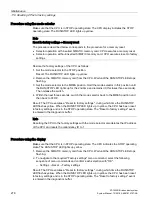
Test functions
12.1 Test functions
S7-1500R/H redundant system
System Manual, 10/2018, A5E41814787-AA
283
Testing with program status
The program status allows you to monitor the execution of the program. You can display the
values of operands and the results of logic operations (RLO). This allows you to detect and
fix logical errors in your program.
Note
Restrictions with the "Program status" function
Monitoring loops can significantly increase the cycle time. The increase in cycle time
depends on the following factors:
•
The number of tags to be monitored
•
The actual numbers of loops run through
WARNING
Testing with program status
Testing with the "Program status" function can cause serious damage and injury if there are
functional disruptions or program errors.
Make sure that you take appropriate measures to exclude the risk of dangerous states
occurring before running a test with the "Program status" function.
Difference between modifying and forcing
The fundamental difference between the modifying and forcing functions is the storage
behavior:
●
Modifying: Modifying tags is an online function and is not stored in the CPU. You can end
the modifying of tags in the watch table or force table or by terminating the online
connection.
●
Forcing: A force job is written to the SIMATIC memory card and is retained after a
POWER OFF. The S7-1500R/H CPU displays an active force job with a symbol. You can
only end the forcing of peripheral inputs and peripheral outputs in the force table.
A force job is transferred to the backup CPU in SYNCUP. The force job is then effective
in both CPUs in the RUN-Redundant system state.
Содержание Simatic S7-1500H
Страница 1: ......















































